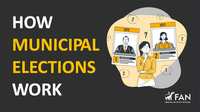Explainer: How Municipal Elections Work
Your municipal vote is one of the most important that you will cast. The way votes determine your local council is complicated, so we've broken it down step by step just for you.
Watch here:
Transcript
When you vote to elect people to represent you in your local municipality, you get two ballots;
- the first is for a person to represent your local geographic ward and,
- the second is a vote for the party which you would like to be in charge of your municipality. This is called the proportional representation or ‘PR ballot’.
Your ward vote can be for someone who represents a party or for an ‘independent’ candidate.
This person will be the political representative for you and your community – they will be the one you go to when having problems in your area, whether it be electricity issues, lack of municipal service delivery or safety concerns.
And how are local council seats determined in your municipality?
A quota of votes needed to gain a seat is worked out by adding the total number of votes cast in that election on both the PR and ward ballots and then dividing it by the number of seats available in the municipality.
All votes cast for a party on the PR ballot and for that party’s candidates on ward ballots are added together. Each party’s total is then divided by the quota to see how many seats they are entitled to.
The number of ward seats already won by that party are then subtracted from the total number of seats allocated to the party. The remainder of seats the party is entitled to are then allocated to councillors on the party’s PR list to ensure the proportion of votes cast for a party roughly matches its proportion of seats.
Your municipal vote is one of the most important that you will cast - make sure you use it wisely. Your ward representative will be the first political representative you go to when you have problems with service delivery – make sure it’s someone you can count on.
Illustration Sources available here.

